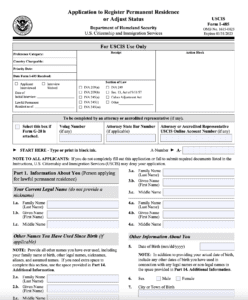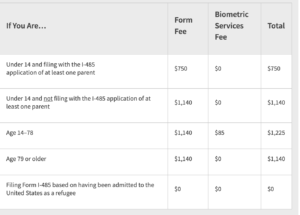Complete Guide to Form I-485 | Step-by-Step Instructions
Form I-485 is used in marriage green card cases and the family-based green card process as a way to apply to register for permanent residency or adjust your status. It comes subsequent to submitting Form 1-130 (Petition for Alien Relative). This guide will explore step-by-step how to complete Form I-485, required documents, and procedures.
If you’re in the midst of the marriage green card process the reason to file Form I-485 is to demonstrate that the foreign partner is eligible for permanent residency in the United States. The applicant for Form I-485 in this case is the foreign spouse. Discuss this with your immigration professional, but in many cases, the foreign spouse can file Form I-485 and I-130 concurrently (along with appropriate fees/supporting documents) if they are in the U.S. and meet the other requirements. Be aware that if you go through the consular processing route and apply for your green card in a country outside the United States, you will not be able to file Form I-485 and I-130 concurrently because with consular processing the forms go to USCIS and the Department of State.
Concurrent Filing Form I-485 and I-130
Form I-485 is able to be filed concurrently with Form I-130 if:
- An immediate U.S. citizen relative (spouses, parents over 21 or children over 21) is sponsoring you
- A visa number is available immediately
- You are a special immigrant juvenile
- Are a self-petitioning battered spouse/child and the person conducting the abuse (spouse/parent) is a citizen
- Are applying for a special immigrant visa; are a member of specific branches of the Armed Forces
Filing Form I-485 Step-by-Step
Part 1. Information About You (Person applying for lawful permanent residence)
The first part of Form I-485, Adjustment of Status Application or Application to Register Permanent Residence is to fill out the information about you, the one applying for lawful permanent residence. Fill out your name, date of birth, sex, city or town of birth, country of citizenship or nationality, Alien Registration Number, USCIS online account number (if applicable), U.S. mailing address, alternate and/or safe mailing address, social security card, recent immigration history. In lines 18-24 you’ll need to provide your recent immigration history so have your passport number readily available, travel document number used at last arrival, expiration date of the passport/travel document, country that issued the passport/travel document, nonimmigrant visa number from the passport, place of last arrival into the U.S. Lines 25.a. – 28.c. ask more questions about your last arrival into the U.S. and if you were issued a Form I-94 Arrival-Departure Record Number.
Part 2. Application Type or Filing Category
This section is very significant because you indicate which immigrant category you are filing under (Family-Based, Employment-Based, Special Immigrant, Asylee or Refugee, Human trafficking Victim or Crime Victim, Special Programs Based on Certain Public Laws, Additional Options)
If you are the principal applicant be prepared to provide your receipt number, full name, A-number, date of birth, receipt number, priority date.
Part 3. Additional Information About You
Questions asked in this section include whether you have ever applied for an immigrant visa to obtain permanent resident status at a U.S. embassy or U.S. consulate abroad. In this section you’ll also be asked for your physical address, dates of residence, most recent address outside the U.S, employment history for the past five years (within or outside the U.S.)
Part 4. Information About Your Parents
In this section, fill out your parent’s legal name, parent’s name at birth, and their personal biographic information.
Part 5. Information About Your Marital History
What is your current marital status? Check the appropriate box in this section. If you are currently married you’ll need to provide your spouse’s legal name and their biographic information. Same goes for prior marriages.
Part 6 & 7: Information About Your Children and Their Biographic Information
Indicate the total number of all living children you have (includes biological and legally adopted, stepchildren of any age and those born to you outside of marriage). You will need to provide the names and biographic information of those children.
Part 8. General Eligibility and Inadmissibility Grounds
If you’ve ever been involved in, or associated with any organization, association, fund, foundation, party, club, society or similar group in the U.S. or in any other location in the world including military service, mark yes in line 1. If you have answered yes to this question fill out the questions pertaining to these organizations in Part 8. This section will also define your eligibility based on whether you have engaged in criminal activity, human trafficking, and a host of other illegal activities.
Part 9. Accommodations for Individuals With Disabilities and/or Impairments
If you are deaf, hard of hearing, blind or have another disability, this section is to request accommodation due to the impairment/disability.
Part 10. Applicant’s Statement, Contact Information, Declaration, Certification, and Signature
In this section, you will declare that your can read and understand English and have read and understood the questions in the form OR had an interpreter assist you in filing the application.
Part 11 and 12 are for details pertaining to the preparer’s full name, and contact information. Part 14 is for additional space to answer previous questions.
I-485 Processing Time
Data from 2022, suggest the average processing time for Form I-485 was between 8-14 months. You will know that USCIS received your application after filing it because you’ll be sent a confirmation of receipt. On this document you’ll see a 10-digital receipt number which will allow you to check your case status.
I-485 Checklist
The following is required as evidence for immediate relatives and family-based preference applicants:
- Two passport-style photographs
- Copy of government ID with photograph
- Copy of birth certificate
- Inspection and admission or inspection and parole documentation
- Documentation of immigrant category (Ex: copy of Form I-797, Approval or Receipt notice for I-130 filed on your behalf)
- Form I-864, Affidavit of Support (if required)
- Certified police and court records of all criminal charges, arrests or convictions (regardless of final disposition)
- Form I-601, Application for Waiver of Grounds of Inadmissibility
- Form I-212, Application for Permission to Reapply for Admission into the U.S. after deportation or removal
- Documents pertaining to J-1 or J-2 exchange visitor status
- Form I-508, Waiver of Diplomatic Rights, Privileges, Exemptions and Immunities
- Form I-566 Interagency Record of Request
- Form I-485 Supplement A, Adjustment of Status Under Section 245(i) (if applicable)
If you are a principal applicant or derivative applicant for Form I-485 the checklist is slightly different. Click here to see it.
I-485 Filing Fee
Currently, the I-485 filing fee varies based on whether you are under 14 and filing with the I-485 application of at least one parent, under 14 and not filing with the I-485 application of at least one parent, between age 14-78, age 79 or older and or have been admitted to the U.S. under refugee status. See the chart below to determine which category you fall into. As you can see from the chart below, the I-485 filing fee ranges from $0 to $1,140.
Want to know the status of your case or I-485 tracker? You can see the status of your case online here.
I-485 Frequently Asked Questions
What if I did not file my form properly?
Expect to receive a Notice of Action to reject your application from USICS or a Request for Evidence to make a decision on your case.
What does the I-485 do?
Form I-485 is an application in marriage green card cases and family-based green card cases to register for permanent residency or adjust your status.
What does it mean I-485 approved?
After your I-485 Adjustment of Status application is approved, you will need to go to the USCIS local office to get a passport stamp (bring any dependents who applied with you). The date your I-485 gets approved is the date of adjustment. Once it is approved you’re considered a lawful permanent resident and are able to work.
What is the difference between I-130 and I-485?
The I-130 is the Petition for Alien Relative, which is the basic step for sponsoring a relative to immigrate to the U.S. In a previous section we discuss filing I-130 and I-485 concurrently if you (the applicant) are within the U.S.
How long does it take to get approval for I-485?
The answer to processing time will largely be impacted by the category of adjustment it is and also the assigned USCIS field office handling your case. In 2022 the average I-485 processing time was 8-14 months.
What is the I-485 filing address?
Where you file your Form I-485 depends on your eligibility category. Go to the Direct Filing Addresses for Form I-485 page to see where you should file your application.
Can Form I-485 be filed online?
Yes, it can be filed online or by mail.
What if my I-485 gets denied?
If it gets denied, the first thing you should do is discuss your options with your immigration attorney. They may recommend creating a motion to reopen or reconsider the decision, appeal it or refile.







